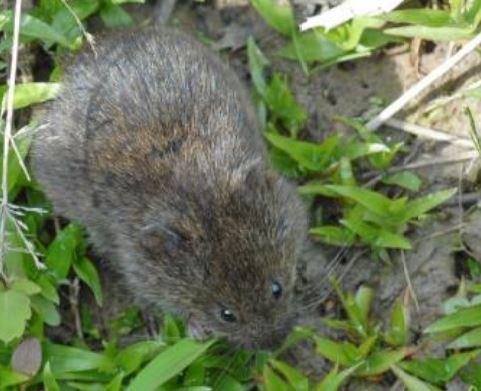Moderate-
High
The Kincaid meadow vole is a subspecies of Microtus pennsylvanicus and is endemic to eastern Washington. Its distribution is poorly defined and there is little current information on the status of populations.
Description and Range
Physical description
The Kincaid meadow vole is a small mammal in the Cricetidae family. It is a large, isolated subspecies of meadow vole. Meadow voles are 5.5 to 8 inches long; their gray tail is 1.2 to 2.4 inches long; and they weigh 0.7 to 2.5 ounces. Males are slightly larger than females.
The fur of adult meadow voles is comprised of two hair types (softer hairs underlying firmer, longer ones). Near the front of the body, the softer hair is gray at the root and white at the tip; at the rear of the body, the soft hair is dark gray at the root, orange or yellow in the middle, and dark at the tip. Firmer hairs on the rear of the body are gray at the root and dark brown at the tip. For more details about meadow voles, visit Animal Diversity Web.
Taxonomic note: Specimens of Kincaid meadow vole at the Slater Museum, University of Puget Sound, from Stevens and Pend Oreille Counties and labeled as this subspecies need to be reexamined and confirmed. A comprehensive taxonomic review of the entire species is warranted.
Ecology and life history
Kincaid meadow voles are found in damp meadows, marshy areas along creeks, and around lakes within the otherwise semi-arid Columbia Basin.
The meadow vole diet consists mainly of grasses, sedges, seeds, roots, bark, and occasionally animal matter.
Meadow voles create distinct runways in dense cover and build a round nest of leaves and stems.
Meadow voles can be prolific. Peak breeding activity occurs April to October, but they may breed throughout the year, when snow provides an insulating layer. Litter size averages four to six. Young are weaned in 10 to 14 days and are sexually mature two to three weeks later.
Geographic range
The Kincaid meadow vole may be endemic to Grant and Lincoln counties. Records exist for sites 10 miles south of Moses Lake, along Crab Creek north of Moses Lake, north to Coulee City, and east to Sylvan Lake. There are specimens of M. pennsylvanicus from Adams, Lincoln, and extreme northern Grant counties that either extend the range of this species, belong to M. p. funebris, or possibly belong to an undescribed subspecies. However, the taxonomic affinities of these specimens have not been examined in detail.
Populations may undergo cyclic fluctuations in abundance every two to five years, but current population size and trends are unknown.
Climate vulnerability
Sensitivity to climate change
Moderate-
High
There is no information on the sensitivity of Kincaid's meadow voles to climate change. In general, meadow voles likely do not exhibit much physiological sensitivity to climate change. However, Kincaid's meadow voles' association with damp meadows, marshy areas along creeks, and around lakes in the Columbia Basin of Washington likely increases this subspecies' sensitivity to the hotter and drier conditions expected in this region. These conditions, which could also result in greater fire occurrence, could degrade or eliminate these habitats. The small range of this taxon, which possibly encompasses just Grant and Lincoln counties, may also increase its vulnerability to climate change impacts.
Exposure to climate change
Moderate
- Increased temperatures
- Changes in precipitation
Conservation
Conservation Threats and Actions Needed
- Resource information collection needs
- Threat: Lack of data on current status and distribution.
- Action Needed: Determine population status and distribution.
- Threat: Lack of information on current threats.
- Action Needed: Determine threats to the population.
See the Climate vulnerability section for information about the threats posed by climate change to this species.
Resources
References
Booth, E. S. 1947. Systematic review of the land mammals of Washington. Ph.D. Dissertation, State College of Washington, Pullman, Washington.
Dalquest, W. W. 1948. Mammals of Washington. University of Kansas Publications, Museum of Natural History 2:1- 444.
MacDonald, S. O., J. A. Cook, G. L. Kirkland, Jr, and E. Yensen. 1998. Microtus pennsylvanicus (Ord 1815) meadow vole. Pp. 99-100 in D. J. Hafner, E. Yensen, and G. L. Kirkland, Jr. (compilers and editors). North American rodents: status survey and conservation action plan. IUCN/SSC Rodent Specialist Group, IUCN, Gland, Switzerland and Cambridge, United Kingdom.
